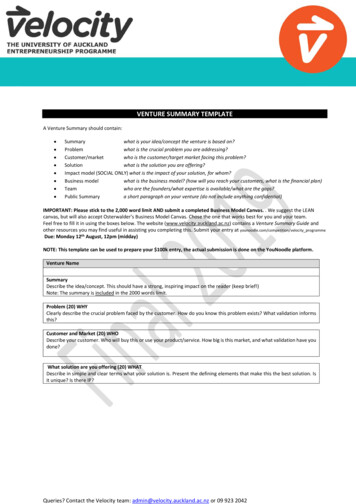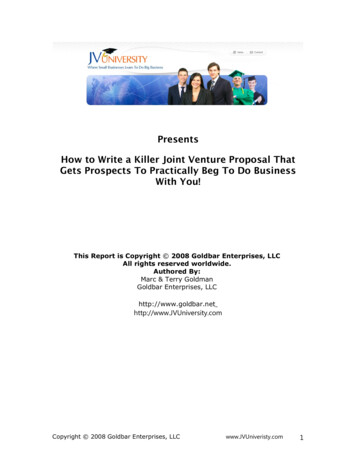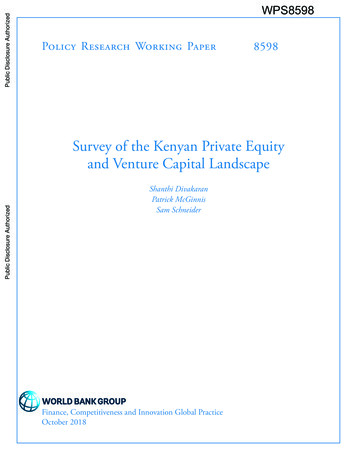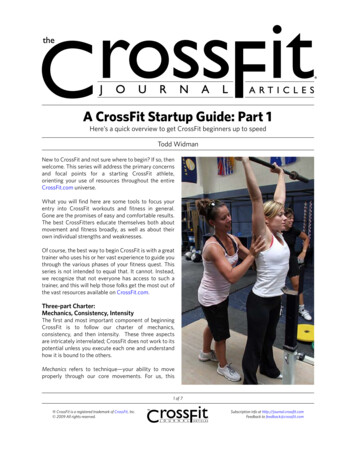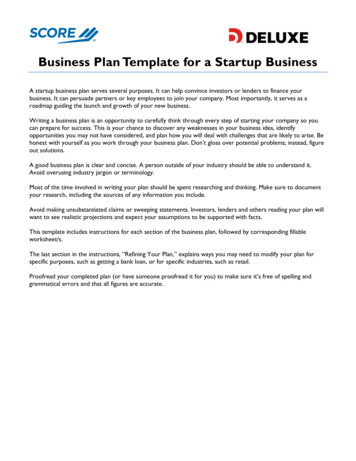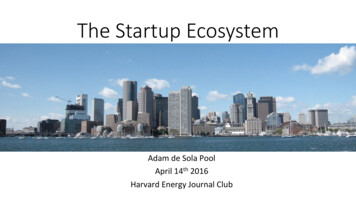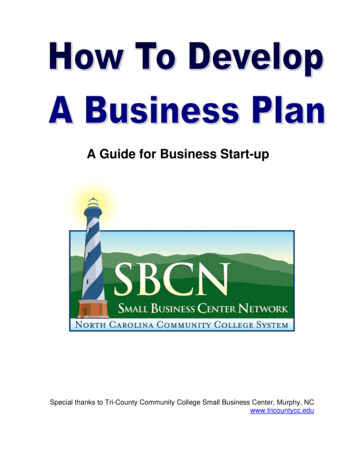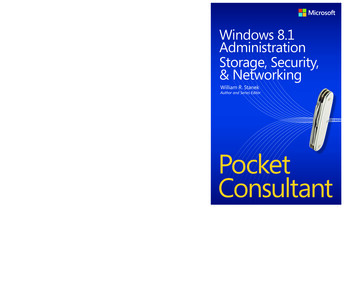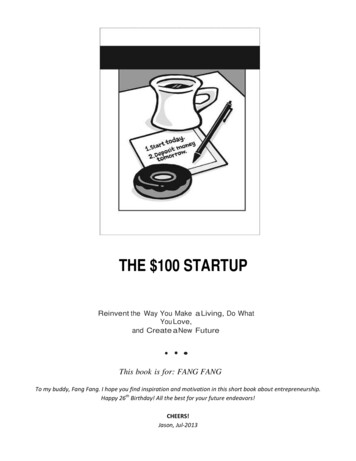
Transcription
THE 100 STARTUPReinvent the Way You Make a Living, Do WhatYou Love,and Create a New Future This book is for: FANG FANGTo my buddy, Fang Fang. I hope you find inspiration and motivation in this short book about entrepreneurship.Happy 26th Birthday! All the best for your future endeavors!CHEERS!Jason, Jul-2013
PROLOGUEManifestoA SHORT GUIDE TO EVERYTHING YOU WANTImagine a life where all your time is spent on the things you want to do.Imagine giving your greatest attention to a project you create yourself, instead of working as a cog in amachine that exists to make other people rich.Imagine handing a letter to your boss that reads, “Dear Boss, I’m writing to let you know that yourservices are no longer required. Thanks for everything, but I’ll be doing things my own way now.”Imagine that today is your final day of working for anyone other than yourself. What if—very soon, notin some distant, undefined future—you prepare for work by firing up a laptop in your home office,walking into a storefront you’ve opened, phoning a client who trusts you for helpful advice, or otherwisedoing what you want instead of what someone tells you to do?All over the world, and in many different ways, thousands of people are doing exactly that. They arerewriting the rules of work, becoming their own bosses, and creating a new future.This new model of doing business is well under way for these unexpected entrepreneurs, most of whomhave never thought of themselves as businessmen and businesswomen. It’s a microbusiness revolution—away of earning a good living while crafting a life of independence and purpose.Other books chronicle the rise of Internet startups, complete with rants about venture capital and talesof in-house organic restaurants. Other guides tell you how to write eighty-page business plans that no onewill ever read and that don’t resemble how an actual business operates anyway.This book is different, and it has two key themes: freedom a n d value. Freedom is what we’re alllooking for, and value is the way to achieve it.
Stumbling onto FreedomMore than a decade ago, I began a lifelong journey of self-employment by any means necessary. I neverplanned to be an entrepreneur; I just didn’t want to work for someone else. From a cheap apartment inMemphis, Tennessee, I watched what other people had done and tried to reverse-engineer their success. Istarted by importing coffee from Jamaica, selling it online because I saw other people making money fromit; I didn’t have any special skills in importing, roasting, or selling. (I did, however, consume much of theproduct through frequent “testing.”)If I needed money, I learned to think in terms of how I could get what I needed by making something andselling it, not by cutting costs elsewhere or working for someone else. This distinction was critical,because most budgets start by looking at income and then defining the available choices. I did itdifferently—starting with a list of what I wanted to do, and then figuring out how to make it happen.The income from the business didn’t make me rich, but it paid the bills and brought me something muchmore valuable than money: freedom. I had no schedule to abide by, no time sheets to fill out, no uselessreports to hand in, no office politics, and not even any mandatory meetings to attend.I spent some of my time learning how a real business works, but I didn’t let it interfere with a busyschedule of reading in cafés during the day and freelancing as a jazz musician at night.Looking for a way to contribute something greater to the world, I moved to West Africa and spent fouryears volunteering with a medical charity, driving Land Rovers packed with supplies to clinics throughoutSierra Leone and Liberia. I learned how freedom is connected to responsibility, and how I could combinemy desire for independence with something that helped the rest of the world.After returning to the United States, I developed a career as a writer in the same way I learned to doeverything else: starting with an idea, and then figuring everything else out along the way. I began ajourney to visit every country in the world, traveling to twenty countries a year and operating my businesswherever I went. At each step along the way, the value of freedom has been a constant compass.There’s no rehab program for being addicted to freedom. Once you’ve seen what it’s like on the otherside, good luck trying to follow someone else’s rules ever again.
The Value DoctrineThe second part of this book is about value, a word that is often used but rarely analyzed. As we’llconsider it, value is created when a person makes something useful and shares it with the world. Thepeople whose stories you’ll read in this book have succeeded because of the value they’ve created. Often,the combination of freedom and value comes about when someone takes action on something he or sheloves to do anyway: a hobby, skill, or passion that that person ends up transforming into a business model.The microbusiness revolution is happening all around us as people say “thanks but no thanks” totraditional work, choosing to chart their own course and create their own future. Small businesses aren’tnew, but never before have so many possibilities come together in the right place at the right time. Accessto technology has increased greatly, and costs have gone down greatly. You can test-market your ideainstantly, without waiting for months to gauge how prospects will respond to an offer. You can open aPayPal account in five minutes and receive funds from buyers in more than 180 countries.Even better, as you build a community of loyal customers, you’ll know well in advance what to makefor them and how likely you are to be successful without investing a lot of money. In fact, the more youunderstand how your skills and knowledge can be useful to others, the more your odds of success will goup.Perhaps most important, the vital career question of what is risky and what is safe has changedpermanently. The old choice was to work at a job or take a big risk going out on your own. The newreality is that working at a job may be the far riskier choice. Instead, take the safe road and go out on yourown.What if you could achieve your own life of freedom by bypassing everything you thought was aprerequisite? Instead of borrowing money, you just start—right now—without a lot of money. Instead ofhiring employees, you begin a project by yourself, based on your specific personal combination ofpassion and skill. Instead of going to business school (which doesn’t actually train people to operate asmall business), you save the 60,000 in tuition and learn as you go.Remember, this book isn’t about founding a big Internet startup, and it isn’t about opening a traditionalbusiness by putting on a suit and begging for money at the bank. Instead, it’s the account of people whofound a way to live their dreams and make a good living from something they cared deeply about. What iftheir success could be replicated? What if there was a master plan you could follow, learning from thosewho have made it happen?
It’s a Blueprint, Not a Vague Series of IdeasI’ll share more of my own story as we go along, but this book isn’t about me—it’s about other people whohave found freedom, and how you can do the same thing. During an unconventional book tour, I traveled tosixty-three cities in the United States and Canada (and eventually more than fifteen additional countries),meeting with people who had made the switch from working for The Man to working for themselves.I then worked with a small team to create a comprehensive, multiyear study involving more than ahundred interview subjects. Combing through reams of data (more than four thousand pages of writtensurvey answers in addition to hundreds of phone calls, Skype sessions, and back-and-forth emails), Icompiled the most important lessons, which are offered here for your review and action. This blueprint tofreedom is fully customizable and highly actionable. At many points along the way, you’ll have a chanceto pause and work on your own plan before continuing to learn more about what other people have done.A few of the people in the study are natural-born renegades, determined to go it alone from youngadulthood onward, but most are ordinary people who had no intention of working on their own until laterin life. Several had been laid off or fired from a job and suddenly had to find a way to pay the bills orsupport a family. (In almost all these cases, they said something like, “Losing my job was the best thingthat ever happened to me. If I hadn’t been pushed, I never would have made the leap.”)Make no mistake: The blueprint does not tell you how to do less work; it tells you how to do betterwork. The goal isn’t to get rich quickly but to build something that other people will value enough to payfor. You’re not just creating a job for yourself; you’re crafting a legacy.This blueprint does not involve secrets, shortcuts, or gimmicks. There are no visualization exerciseshere. If you think you can manifest your way to money simply by thinking about it, put this book down andspend your time doing that. Instead, this book is all about practical things you can do to take responsibilityfor your own future. Read it if you want to build something beautiful on the road to freedom.Can you transition to a meaningful life oriented toward something you love to do? Yes. Can you makemoney doing it? Yes, and here are the stories of people who have led the way. Is there a path you canfollow for your own escape plan? Yes—here is the path. Follow it to create the freedom you crave.
YOU ALREADY HAVE THE SKILLS YOU NEED—YOU JUST HAVE TO KNOW WHERE TO LOOK.“The need for change bulldozed a roaddown the center of my mind.”—M AYA ANGELOUOn the Monday morning of May 4, 2009, Michael Hanna put on a Nordstrom suit with a colorful tie andheaded to his office building in downtown Portland, Oregon. A twenty-five-year veteran salesprofessional, Michael spent his days attending meetings, pitching clients, and constantly responding toemail.Arriving at work, he settled into his cubicle, reading the news and checking a few emails. One of themessages was from his boss, asking to see him later that day. The morning passed uneventfully: moreemails, phone calls, and planning for a big pitch. Michael took a client out to lunch, stopping off for anespresso recharge on the way back in. He returned in time to fire off a few more replies and head to theboss’s office.Inside the office, Michael took a seat and noticed that his boss didn’t make eye contact. “After that,” hesays, “everything happened in slow motion. I had heard story after story of this experience from otherpeople, but I was always disconnected from it. I never thought it could happen to me.”His boss mentioned the downturn in the economy, the unavoidable need to lose good people, and so on.An H.R. manager appeared out of nowhere, walking Michael to his desk and handing him a cardboard box—an actual box!—to pack up his things. Michael wasn’t sure what to say, but he tried to put on a braveface for his nearby colleagues. He drove home at two-thirty, thinking about how to tell his wife, MaryRuth, and their two children that he no longer had a job.After the shock wore off, Michael settled into an unfamiliar routine, collecting unemployment checksand hunting for job leads. The search was tough. He was highly qualified, but so were plenty of otherpeople out pounding the pavement every day. The industry was changing, and it was far from certain thatMichael could return to a well-paying job at the same level he had worked before.One day, a friend who owned a furniture store mentioned that he had a truckload of closeout mattressesand no use for them. “You could probably sell these things one at a time on Craigslist and do pretty well,”he told Michael. The idea sounded crazy, but nothing was happening on the job front. Michael figured ifnothing else, he could at least sell the mattresses at cost. He called Mary Ruth: “Honey, it’s a long story,but is it OK if I buy a bunch of mattresses?”The next step was to find a location to stash the goods. Hunting around the city, Michael found a cardealership that had gone out of business recently. Times were hard in the real estate business too, so whenMichael called the landlord to see if he could set up shop inside the old showroom, he had a deal. The
first inventory went quickly through Craigslist and word of mouth, and the biggest problem was answeringquestions from potential customers about what kind of mattress they should buy. “I had no business planand no knowledge of mattresses,” Michael said. “My impression of mattress stores was that they wereseedy, high-pressure places. I wasn’t sure what kind of place I was trying to build, but I knew it had to bea welcoming environment where customers weren’t hassled.”After the first experience went well, Michael took the plunge and studied up on mattresses, talking tolocal suppliers and negotiating with the landlord to remain in the former car showroom. Mary Ruth built awebsite. The concept of a no-hard-sell mattress store went over well in Portland, and business grewwhen the store offered the industry’s first-ever mattress delivery by bicycle. (A friend built a customtandem bike with a platform on the back that could hold a king-size mattress.) Customers who rode theirown bikes to the store received free delivery, a pricing tactic that inspired loyalty and a number of fanvideos uploaded to YouTube.It wasn’t what Michael had ever expected to do, but he had built a real business, profitable right fromthe first truckload of mattresses and providing enough money to support his family. On the two-yearanniversary of his abrupt departure from corporate life, Michael was looking through his closet when hespotted the Nordstrom suit he had worn on his last day. Over the last two years, he hadn’t worn it—or anyother professional dress clothes—a single time. He carried the suit out to his bike, dropped it off atGoodwill, and continued on to the mattress store. “It’s been an amazing two years since I lost my job,” hesays now. “I went from corporate guy to mattress deliveryman, and I’ve never been happier.”Across town from Michael’s accidental mattress shop, first-time entrepreneur Sarah Young was opening ayarn store around the same time. When asked why she took the plunge at the height of the economicdownturn and with no experience running a business, Sarah said: “It’s not that I had no experience; I justhad a different kind of experience. I wasn’t an entrepreneur before, but I was a shopper. I knew what Iwanted, and it didn’t exist, so I built it.” Sarah’s yarn store, profiled further in Chapter 11, was profitablewithin six months and has inspired an international following.Meanwhile, elsewhere around the world, others were skipping the part about having an actualstorefront, opening Internet-based businesses at almost zero startup cost. In England, Susannah Conwaystarted teaching photography classes for fun and got the surprise of her life when she made more moneythan she did as a journalist. (Question: “What did you not foresee when starting up?” Answer: “I didn’tknow I was starting up!”)Benny Lewis graduated from a university in Ireland with an engineering degree, but never put it to use.Instead he found a way to make a living as a “professional language hacker,” traveling the world andhelping students quickly learn to speak other languages. (Question: “Is there anything else we shouldknow about your business?” Answer: “Yes. Stop calling it a business! I’m having the time of my life.”)Welcome to the strange new world of micro-entrepreneurship. In this world, operating independentlyfrom much of the other business news you hear about, Indian bloggers make 200,000 a year. Roaming,independent publishers operate from Buenos Aires and Bangkok. Product launches from one-man or onewoman businesses bring in 100,000 in a single day, causing nervous bank managers to shut down theaccounts because they don’t understand what’s happening.Oddly, many of these unusual businesses thrive by giving things away, recruiting a legion of fans andfollowers who support their paid work whenever it is finally offered. “My marketing plan is strategicgiving,” said Megan Hunt, who makes hand-crafted dresses and wedding accessories in Omaha,Nebraska, shipping them all over the world. “Empowering others is our greatest marketing effort,” saidScott Meyer from South Dakota. “We host training sessions, give away free materials, and answer anyquestion someone emails to us at no charge whatsoever.”In some ways, renegade entrepreneurs who buck the system and go it alone are nothing new.
Microbusinesses—businesses typically run by only one person—have been around since the beginning ofcommerce. Merchants roamed the streets of ancient Athens and Rome, hawking their wares. In many partsof rural Africa and Asia, much commerce still takes place through small transactions and barter.Unconventional approaches to marketing and public relations have also been around for a while. Longbefore it was common, a band had an idea for communicating directly with fans, bypassing the traditionalstructure of record labels as much as possible. The fans felt like they were part of a community instead ofjust a crowd of adoring listeners. Oh, and instead of relying primarily on album sales for income, the bandwould rely on ticket sales and merchandising at an unending series of live concerts. The example soundslike it’s happening today, but the year was 1967, and the band was the Grateful Dead.What’s new, however, is how quickly someone can start a business and reach a group of customers.The building process is much faster and cheaper today than it has ever been. Going from idea to startupcan now take less than a month and cost less than 100—just ask any of the people whose stories you’llread in this book. Commerce may have been around forever, but scale, reach, and connection havechanged dramatically. The handyman who does odd jobs and repairs used to put up flyers at the grocerystore; now he advertises through Google to people searching for “kitchen cabinet installation” in theircity.It’s not an elitist club; it’s a middle-class, leaderless movement. All around the world, ordinary peopleare opting out of traditional employment and making their own way. Instead of fighting the system, they’recreating their own form of work—usually without much training, and almost always without much money.These unexpected entrepreneurs have turned their passion into profit while creating a more meaningfullife for themselves.What if you could do this too? What if you could have the same freedom to set your own schedule anddetermine your own priorities? Good news: Freedom is possible. More good news: Freedom isn’tsomething to be envisioned in the vaguely distant future—the future is now.The 100 Startup ModelI’ve been hearing stories about unconventional businesses for at least a decade, even as I’ve beenoperating a series of them myself. Through my work as a writer and entrepreneur, I had access to a widecircle of microbusiness case studies: profitable businesses typically run solely by one person withoutmuch in the way of startup capital. In preparing for a comprehensive study, I began by checking with manyof my friends and colleagues, but I didn’t stop there.In 2010 I produced a series of workshops on low-budget business ideas with Pamela Slim, author ofEscape from Cubicle Nation. The first time we announced a workshop, it sold out in ninety minutes. Wethen offered spots in another workshop that wouldn’t be held for several months, and it sold out beforelunchtime. Since it was clear we had found a demand for this information, I dug deeper.While hosting the workshops, I became interested in the “follow-your-passion” model—the idea thatsuccessful small businesses are often built on the pursuit of a personal hobby or interest. I conductedinterviews with entrepreneurs all over the world and documented their stories for an online course calledthe Empire Building Kit . The course was the inspiration for launching the project on a wider scale andthen for writing this book.I had a number of case studies in mind at the outset, but in preparation for writing the book, I cast thenet much wider. I drew respondents from online and offline, collecting data through a Google form thatgrew to thousands of data points. As I traveled to sixty-three cities in North America on a book tour, I
kept meeting and hearing about more unconventional, accidental entrepreneurs.When I finally closed the nomination process, I had more than 1,500 respondents to choose from. All ofthe respondents met at least four of the following six criteria: Follow-your-passion model. Many people are interested in building a business that is based on ahobby or activity they are especially enthusiastic about. As we’ll see, not every passion leads tobig bank deposits, but some certainly do. Low startup cost. I was interested in businesses that required less than 1,000 in startup capital,especially those that cost almost nothing (less than 100) to begin. At least 50,000 a year in net income. I wanted profitable businesses that earned at least as muchas the average North American income. As we go along, you’ll notice that the range variesconsiderably, with many businesses earning healthy six-figure incomes or higher, but a baselineprofitability level of at least 50,000 a year was required. No special skills. Since we were looking at ordinary people who created a successful business, Ihad a bias toward businesses that anyone can operate. This point can be hard to define, but there’sa key distinction: Many businesses require specialized skills of some kind, but they are skills thatcan be acquired through a short period of training or independent study. You could learn to be acoffee roaster on the job, for example, but hopefully not a dentist. Full financial disclosure. Respondents for the study agreed to disclose their income projection forthe current year and actual income for at least the previous two years. Furthermore, they had to bewilling to discuss income and expenses in specific terms. Fewer than five employees. For the most part, I was interested in unexpected or accidentalentrepreneurs who deliberately chose to remain small. Many of the case studies are frombusinesses operated strictly by one person, which closely relates to the goal of personal freedomthat so many respondents identified.I excluded businesses that were in “adult” or quasi-legal markets, and in most cases also excludedbusinesses that were highly technical or required special skills to operate. The baseline test was, “Couldyou explain what you do to your grandmother, and would you be willing to?”Next, I wanted to look at businesses started by people all over the world. About half of our storiescome from the United States, and half come from the rest of the world. From Silicon Valley to Atlanta, theU.S. is a hub for entrepreneurship, both in terms of values and ease of startup. But as we’ll see, peoplefrom all over the world are creating their own microbusinesses, sometimes following the U.S. model andother times doing it independently.Finally, in making the last selections for the studies presented here, I had a bias toward “interesting”stories. Not every business needs to be sexy or trendworthy—in fact, many of the ones here aren’t—but Iliked stories that highlighted originality and creativity. Two years ago in Minneapolis, Lisa Sellmanattracted my attention by telling me about her dog care business. At first, I didn’t think much of it. Howprofitable could a dog care business be? But then Lisa told me how much money she made: 88,000 theprevious year and on track to clear six figures the next. All of a sudden I was interested. How did Lisa doit and what lessons could we learn from her?Each case study subject completed several detailed surveys about his or her business, includingfinancial data and demographics, in addition to dozens of open-ended questions. The group surveys werefollowed up with further individual questions in hundreds of emails, phone calls, Skype video calls, andin-person meetings in fifteen cities around the world. My goal was to create a narrative by findingcommon themes among a diverse group. The collected data would be enough for several thick books byitself, but I’ve tried to present only the most important information here. You can learn more about the
methodology for the study, including survey data and specific interviews, at 100startup.com.In other studies, books, and media coverage, two kinds of business models get most of the attention.Business model number one is old-school: An inventor gets an idea and persuades the bank to lend hermoney for a growing operation, or a company spins off a division to create another company. Mostcorporations traded on the stock market fit this category. Business model number two is the investmentdriven startup, which is typically focused on venture capital, buyouts, advertising, and market share. Thebusiness is initiated by a founder or small group of partners, but often run by a management team,reporting to a board of directors who seek to increase the business’s valuation with the goal of “goingpublic” or being acquired.Each of the older models has strengths, weaknesses, and various other characteristics. In both of them,there is no shortage of success and failure stories. But these models and their stories are not our concernhere. While business models number one and number two have been getting all the attention, somethingelse has been happening quietly—something completely different.Our story is about people who start their own microbusinesses without investment, without employees,and often without much of an idea of what they’re doing. They almost never have a formal business plan,and they often don’t have a plan at all besides “Try this out and see what happens.” More often than not,the business launches quickly, without waiting for permission from a board or manager. Market testinghappens on the fly. “Are customers buying?” If the answer is yes, good. If no, what can we do differently?Like Michael’s progression from corporate guy to mattress bicyclist, many of our case studies startedbusinesses accidentally after experiencing a hardship such as losing a job. In Massachusetts, JessicaReagan Salzman’s husband called from work to say he was coming home early—and he wouldn’t begoing back to the office the next day. The unexpected layoff catapulted Jessica, new mother to a threeweek-old, into action. Her part-time bookkeeping “hobby” became the family’s full-time income. InPennsylvania, Tara Gentile started her business with the goal of being able to work from home whilecaring for her children; the business grew so quickly that her husband ended up staying home too.Across the Atlantic, David Henzell was a director for the largest advertising agency outside London.He left in part because he was bored with the work, and in part because of a diagnosis of chronic fatiguesyndrome that left him struggling with “chronic director responsibilities.” In his new company, LightbulbDesign, he makes the rules. “For a while the illness managed me,” he said, “but now I manage it.Lightbulb started as a way for me to make a living on my terms. It’s still on my terms, but now we arekicking ass!”The people we’ll meet vary considerably in the ways they chose to structure their projects. Someeventually opted for expansion, either by hiring or building teams of “virtual assistants.” Erica Cosminskygrew her transcription team to seventeen people at one point, but by working with contractors instead ofhiring employees, she retained the freedom to keep things simple. The Tom Bihn luggage factory in Seattlegrew to a seven-figure operation, while remaining completely independent and turning down offers to sellits line to big-box stores.Others pursued partnerships that allowed each person to focus on what he or she was best at. Fresh outof design school and disillusioned with their entry-level jobs, Jen Adrion and Omar Noory began sellingcustom-made maps out of an apartment in Columbus, Ohio. Patrick McCrann and Rich Strauss werecompetitors who teamed up to create a community for endurance athletes. Several of our stories are aboutmarried couples or partners building a business together.But many others chose to go it alone, with the conviction that they would find freedom by workingprimarily by themselves. Charlie Pabst was a successful architect with a “dream job” as a store designerfor Starbucks. But the desire for autonomy overcame the comfort of the dream job and the free lattes:“One day I drove to work and realized I couldn’t do it anymore, called in sick, drafted my two-weeknotice, and the rest is history.” Charlie still works as a designer, but now he works from home for clients
of his choosing.We’ll view these stories as an ensemble: a group of individual voices that, when considered together,comprise an original composition. In sharing how different people have set themselves free fromcorporate misery, the challenge is to acknowledge their courage without exaggerating their skills. Most ofthem aren’t geniuses or natural-born entrepreneurs; they are ordinary people who made a few keydecisions that changed their lives. Very few of our case studies went to business school, and more thanhalf had no previous business experience whatsoever. Several dropped out of college, and others neverwent in the first place.*In sharing these stories, the goal is to provide a blueprint for freedom, a plan you can use to apply theirlessons to your own escape plan. Throughout the case studies, three lessons of micro-entrepreneurshipemerge. We’ll focus on these lessons in various ways throughout the bo
business by putting on a suit and begging for money at the bank. Instead, it’s the account of people who found a way to live their dreams and make a good living from something they cared deeply about. What if their success could be replicated? What if there was a master plan you c

